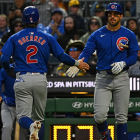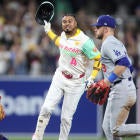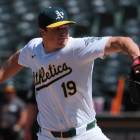Sandy Koufax will forever be known as one of the greatest pitchers to ever walk the Earth. There are those who would argue that at his peak, he might have been the greatest.
There's no questioning that magical peak. From 1961 through 1966, Koufax led the league in ERA five times, won 25 or more games three times, topped 300 innings three times, led the league in strikeouts four times and shutouts three times, made six All-Star teams, won three Cy Young awards, won one regular-season Most Valuable Player award, and two World Series MVPs. He fought through constant, excruciating arm pain, firing his blazing fastball and tantalizing curve with verve. He's a Hall of Famer, and a true baseball legend.
He also pitched in the most favorable environment since the Dead Ball Era. Major League Baseball aggressively raised pitchers' mounds during Koufax's heyday, making that fiery fastball all the more intimidating, that curve all the more knee-bending. Koufax's home park of Dodger Stadium was one of the most favorable in the league for pitchers, and much of the rest of the National League was likewise populated by spacious parks that were forgiving for pitchers. Furthermore, the 250-pound behemoths of today were practically non-existent in Koufax's time, with middle infielders often scrawny little guys who were near automatic outs.
We still recognize Koufax's greatness, because a ballplayer can still be exceptional, even beyond the extremely favorable conditions that help enable his success. We can say that Koufax was an all-time great and that a lot of pitchers would've fared pretty well under similar circumstances. Two things can be true at the same time.
This is why Larry Walker should be a Hall of Famer, and why Todd Helton also deserves serious consideration.
There's no disputing the fact that offense was supercharged in the 1990s and early 2000s, in a way rarely seen before in baseball history. The combination of PED use, lively baseballs, shrinking ballparks, and other factors fueled an explosion of run-scoring throughout the era in which Walker and Helton played. Coors Field was the juiciest of that offense-juicing era, routinely churning out double-digit run totals for the Rockies as a whole, and video-game numbers for their best hitters. Helton never hits .372 without the benefit of Coors Field. Walker doesn't flirt with a 1.200 OPS twice in three years if not for the boost provided by Coors Field.
We can acknowledge Coors Field's effect on both hitters, and still recognize their greatness. Walker was a hellacious hitter in his prime, and during the height of his powers (in 1997-1999) batted .314/.410/.592 on the road. He posted offensive numbers that were 47 percent better than league average during his time with the Rockies, and 40 percent better than league average for his career as a whole. He was also a five-tool player, a seven-time Gold Glove winner and elite baserunner in addition to being a devastating threat with a bat in his hands. He compares favorably to the best right fielders of all time, ranking 10th at that position by advanced metrics. In short, he raises the bar for Cooperstown inductees, even after accounting for all of that mile-high thin air.
In his 17 major-league seasons, Helton batted .316/.414/.539, socking 369 homers, knocking in 1,406 runs, and scoring 1,401. He made five All-Star teams, won four Silver Slugger awards and three Gold Gloves, and claimed a batting title in 2000, the year he also led the league in on-base percentage, slugging, hits, doubles, total bases and runs batted in. Adjust for Coors Field's offense-inflating effects and Helton's career rate stats put him in line with Hall of Famers like George Brett, Rickey Henderson, Wade Boggs and Rod Carew...though also lesser lights like Tommy Pham and Travis Hafner. Jay Jaffe's JAWS system, which evaluates players' numbers based on both peak and career contributions, then ranks them based on historical Hall of Fame standards, places Helton slightly below the median Hall of Famer first baseman ... though it does the same for Eddie Murray and Hank Greenberg, two Cooperstown inductees with numbers that sit in the same neighborhood as Helton's. You can leave Helton off your Hall of Fame ballot and be justified in doing so. But to blithely wave away his entire career because he happened to play 17 years in Colorado disrespects both the player and the process of voting.
If you're going to be serious about voting for the Hall, you have to consider context with every step. That should be the case when pondering Walker and Helton, and considering them not just as products of a favorable environment but as next-generation versions of Koufax.
It should be the case when evaluating the candidacy of Barry Bonds and Roger Clemens. Yes, we have strong anecdotal evidence to suggest that both superstars may have used performance-enhancing drugs during the course of their careers. But we could say the same about amphetamine users like Hank Aaron and Willie Mays. In both eras, the people who ran the game deemed it acceptable to look the other way while players took substances to improve their results on the field, resulting in epidemic-level usage during the greenies and steroids eras. If the best players from the era that served bowls full of greenies like they were M&Ms are going to make it into the Hall, then it's hypocritical to deny entry to the top performers during the time when everyone looked like the Hulk and no one bothered to say anything about it.
Likewise, it should be the case when evaluating the candidacies of great pitchers like Curt Schilling and Mike Mussina. Schilling and Mussina shoudn't be penalized for falling short of 300 wins, because they played during the era of five-man rotations and more aggressive bullpen usage, making it tougher for them to rack up huge wins totals the way their predecessors did. And while some might argue that only the cream of the crop from a particular era should make the Hall, that argument ignores the many, many players already in whose names are not Ruth and Cobb. It's not Schilling's fault or Mussina's fault that they happened to be contemporaries of Clemens, Greg Maddux, Randy Johnson and Pedro Martinez, and Schilling and Mussina both sport numbers that compare favorably to the median Hall of Famers among starting pitchers.
You can and should apply context for each and every voting decision. Scott Rolen might not have the sexy profile that Mariano Rivera does, but the combination of his impressive bat and out-of-this-world defense make him a pretty decent comp to Brooks Robinson, who was a first-ballot Hall of Famer. Are you an Omar Vizquel supporter? Then ask yourself why you'd vote for a player who did less to help his team win than fellow shortstop and 2019 Hall candidate Miguel Tejada (who has no chance to get in), let alone the all-time legends of the sport.
My ballot* has Bonds, Clemens, Schilling, Mussina, Walker, Manny Ramirez, Edgar Martinez, Rolen, Rivera and Roy Halladay on it, with Andruw Jones a strong possibility if the Hall would let voters pick more than 10 candidates (and Helton falling just short). Wherever your own ballot might end up, just make sure that context remains king throughout the process. You need great numbers to make the Hall, but we need to understand what those numbers mean first.
*To earn voting rights, a writer must be an active Baseball Writers Association of America member for 10 years. I've got five to go. So consider this a hypothetical ballot.






















